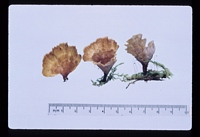|
 Podoscypha pergamena Podoscypha pergamena
SynonymsStereum pergameneum
BiostatusPresent in region - Indigenous. Non endemic
Images (click to enlarge)
Caption: JWE
Owner: Herb. PDD |
Article: Cunningham, G.H. (1963). The Thelephoraceae of Australia and New Zealand. New Zealand Department of Scientific and Industrial Research, Bulletin 145: 359 p. Wellington:.
Description: Hymenophore annual, coriaceous,
solitary, stipitate. Pilei infundibuliform or campanulate, sometimes split along
one side when becoming flabelliform, 10-20 mm tall, 10-20 mm wide; pileus
surface tan or chestnut, radiately sulcate, concolorous or with darker bands
which are somewhat tomentose, with hairs more densely arranged above stems;
hymenial surface when fertile grey, when sterile some shade of brown, scantily
vertically creviced when old; margin thinning out, concolorous or lighter,
dentate or often deeply incised. Stems to 10 x 2 mm, equal, bay, velutinate with
prominent hairs, arising from well developed mycelial discs. Context white or
isabelline, 0.25-0.4 mm thick, of radiately arranged parallel hyphae, with a
coloured cortex bearing abhymenial hairs which may be brief or elongate, with
rounded or moniliform apices and walls to 1 µm thick; skeletal hyphae to 4 µm
diameter, lumena almost capillary; generative hyphae 3.5-4 µm diameter, walls
0.2 µm thick, with clamp connections. Gloeocystidia arising from the context
beneath the subhymenium, sometimes extending parallel with the hymenium,
subventricose or flexuous-cylindrical, often moniliform, not or slightly
projecting, to 120 x 12 µm. Hymenial layer to 80 µm deep, a dense palisade of
basidia, paraphyses, and gloeocystidia. Basidia subclavate, 20-30 x 5-6 µm,
bearing 2-4 spores; sterigmata slender, erect, to 4 µm long. Paraphyses
subclavate, 16-26 x 4-5 µm. Spores broadly elliptical, apiculate, 5-6 x 3.5-4
µm, walls smooth, hyaline, 0.2 µm thick.
Habitat: HABITAT: Solitary or gregarious on decayed decorticated wood lying upon
the forest floor.
Distribution: DISTRIBUTION: North, South,
and Central America, West Indies, New Zealand.
Notes: Collections listed agree with authentic specimens examined in Kew
herbarium. In microfeatures the species resembles S. affine and S.
elegans, differing in that gloeocystidia are of greater diameter and
possess thicker walls (0.5-1 µm). Spores are of the same size and shape as those
of S. elegans, but larger than those of S. surinamense. Pileus
hairs are more strongly developed than in S. affine and S.
elegans, although of similar shape and diameter. They occur in zones on the
pileus surface and irregularly above the stem. The latter is strongly velutinate
as in S. affine and arises from a mycelial disc. S. ravenelii
Berk. & Curt. is similar, differing mainly in the glabrous pileus,
which may be a variable condition. About 30 species of small stipitate
Stereums have been described. Most examined in Kew herbarium appear to
be forms of half a dozen basic species, having been erected on slight
differences in shape, size, or colour of pilei, colour of the hymenium, or upon
the nature of the substratum. They may be divided into two groups, upon whether
hyphal systems are monomitic (S. pusiolum)or dimitic (S. afffine,
S. elegans, S. pergamenum, S. surinamense, S. thozetii),and within these a
few may be delimited by spore size. Separation of the others can be made only
upon variable macrofeatures, consequently most will have to be suppressed when a
large series of specimens is studied critically.
|